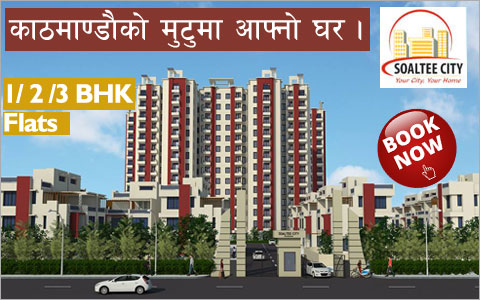National News

Karuna Neupane Subedi
The recent earthquake in Nepal has drawn people’s attention to prefabricated house as a safer alternative to concrete structures. Prefabricated or prefab buildings that simply require assembling of different sections that comes readymade are light weight and can survive earthquakes. Unlike the much opted for solid concrete houses that were brought down to a mere pile of rubbles, prefab houses can be re-fixed even if it gets disassembled by the quake. Different companies working in the making of such houses have come up with different designs and structures in order to provide temporary dwelling to people who have lost their homes in the calamity as well as change the patterns of existing homes in the country.
“The type of prefab houses we are making right now is more of an immediate shelter for the people before the monsoon begins,” said Subarna Newar, MD of GOGREENepal. “These houses have an average life of four to five years and sometimes even more,” she stated. Informing that pre earthquake, the concept of prefab house was not very popular, she said, “There are a small number of prefab home builders in Nepal with an even smaller number of houses.” According to her, it is a safer alternative as the house still stands after the earthquake and causes no damage even if it falls apart. “Besides that, it is easy to install and comparatively cheaper,” she added. The materials needed to make the house are made off the site and assembled in the space where the house stands. According to her, they provide two options- prefab glass or galvanised roof as a ceiling of the house, whereas for the wall they use cement fibre board made of sawdust which is fire and damp proof. The cemented platform is raised to a certain level so that water does not flow in during heavy rains. “We import the cement fibre board and prefab glass from India, while the galvanised roof is locally sourced,” she mentioned. Installed in a day, the cost of a small house of 8x9 feet is Rs 50,000 excluding the transportation charge. Likewise, for a community hall which can serve up to 50 people the cost is Rs 600,000.
Likewise, Bira Furniture, another builder of prefab houses in Nepal is hopeful about changing the scenario of housing. “Pre earthquake, prefab houses were mostly used by hydropower companies and some other projects only,” said Suresh Shrestha, MD of Bira Furniture adding, “At times we would not have a single project on hand, which made it difficult for prefab builders in Nepal to sustain.” According to him, post earthquake a lot of people seem to be interested in building such houses. “It might take a little time to fulfil the growing demand as we lack manpower, but it is not impossible,” he stated. Cost of the houses that Bira builds varies in accordance to size — Rs 629,000 for a one bedroom, kitchen and hall, Rs 900,000 for two bedroom and 1.1 million for three bedroom houses.
Similarly they offer two cement boards — 50 mm and 75, which are manufactured in India. “We use aluminium windows and zinc sheet for the roof and it is supported by iron poles,” he informed. The company also offers wooden board as an option, but cost is slightly higher than the cement board. These houses can sustain on an average of up to 40 to 50 years. “One big advantage of this house beside earthquake resistance is that it can be moved to different places,” he said. “The massive loss of property and lives has compelled people to think about prefab houses, which are clearly safer,” said Narendra Maharjan, Business DevelopmentManager of Arati & Company. According to him, the company builds houses as per the demand of the people which also determines the cost of the houses. The starting price of a house the company offers is Rs 250,000 and it can last at least 20 years to 30 years. “Government too seem to be interested in prefab houses and is changing its policy in order to prioritise it,” he mentioned. According to him, government owned offices, hospitals, schools and other buildings should also employ this technology so that the devastated properties would not take years to re-build, and at the same time not be prone to destruction by another such disaster. Low in cost, these houses appear to be lighter and safer than concrete houses.
The companies installing such houses offer a wide range of designs from single room sto the multi- storied modern houses. There are very few companies working to build prefab houses in Nepal among which many are of small scale. Most of the builders import the cement board from India as Nepal lacks its own manufacturing. However, the labour and material it requires are local. Companies in Nepal pay 25 to 30 per cent tax while importing these cement board. Post earthquake, foreign companies too seem to be interested in the Nepali market as they see great demand for such houses.
source:Karuna Neupane Subedi, The Himalayan Times, 24 may 2015
- 9th Nepal Buildcon International Expo 2024
- Real Estate Expo 2023
- NRB raises housing loan limit to encourage home constructions
- Nepal Rastra Bank (NRB) Monetary Policy 2080-2081
- New Price of Land in Kathmandu Metropolitan City, Nepal
- Capital Gains Tax Rate on Real Estate Transactions in Nepal 2080-81 ( 2023/24 )
- Kathmandu metropolis implements free parking policy for commercial buildings and hospitals

![[X]](https://www.housingnepal.com/images/popup-close-button.png)






























































































































































































































































































































































































 Facebook
Facebook
 Delicious
Delicious
 Digg
Digg
 Reddit
Reddit
 Stumble Upon
Stumble Upon









